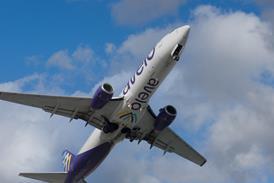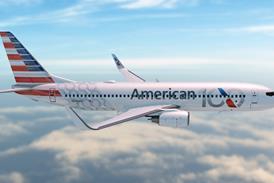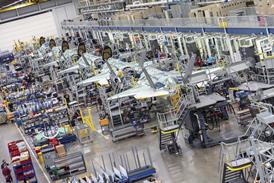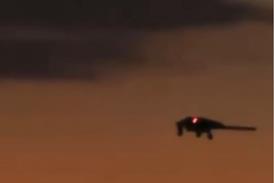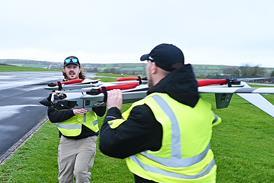American Airlines and US Airways announced their merger with much fanfare at Dallas/Fort Worth International airport on Valentine's Day in 2013.
The chief executives of both carriers promised significant revenue benefits that would improve shareholder value and create long-term job security for employees while creating the world’s largest airline, all in one fell swoop in the announcement made in American’s Admirals Club in terminal D.
"This is an extremely complementary merger," said Doug Parker, then chief executive of US Airways and now chief executive of American, that morning. "I've long been a proponent of industry consolidation. This is the last needed piece to rationalise the [US] airline industry."
He and then American chief Tom Horton outlined at least $1.05 billion in annual revenue synergies by the end of 2015 at a cost of about $1.2 billion on three years. Revenue synergies were subsequently increased by $400 million to $1.45 billion in January 2014.
More than two-and-a-half years later, with the US Airways name ready to fly into the sunset tomorrow, 17 October, has American met its own expectations?
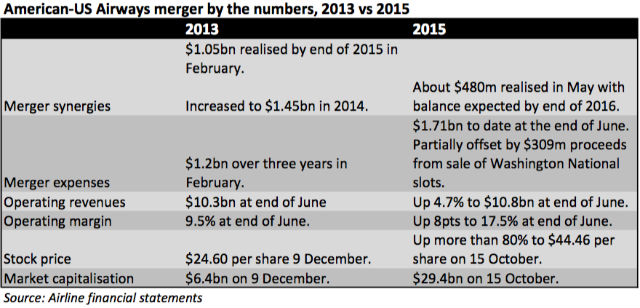
WAITING FOR SYNERGIES
The revenue results are mixed. The Fort Worth, Texas-based carrier had only realised about a third of the anticipated $1.45 billion in synergies – about $480 million – as of this May, said president Scott Kirby that month. This is well short of the full amount by the end of 2015 target.
The delay is almost entirely due to the migration of US Airways reservations to American’s Sabre system tomorrow, something that early integration timelines suggested would occur earlier on in the merger process.
Kirby said in July that many of the potential connectivity and fleet optimisation synergies could not be realised until after the reservations integration.
“If you go out and look at usairways.com and american.com, just as a simple example, you will often find different prices,” he said. “That’s because of the inherent challenges with running a codeshare as opposed to having a seamless single system. And so all that goes away once we are on a single reservation system.”
Another, largely unmentioned impact, was the US Department of Justice’s (DOJ) unexpected challenge to the American-US Airways deal in August 2013. This likely pushed back regulatory approval, and the subsequent integration, by about three to six months.
Analysts are largely willing to give American a pass on the revenue benefits, at least through 2016.
“It’s still early,” says Hunter Keay, an analyst at Wolfe Research. “I think 2016 is going to be the year of the revenue synergies, so we don’t know yet. It’s pretty clear they’ve created shareholder value through earnings growth.”
American’s stock price has increased more than 80% to $44.46 per share at close on 15 October from $24.60 per share when the merger closed on 9 December 2013. Its market capitalisation has increased $23 billion to $29.4 billion during the period.
Operating revenues increased about 4.7% to $10.8 billion in the second quarter compared to the combined results of the then-independent American and US Airways in the second quarter of 2013.
American’s operating margin has increased a more impressive eight-percentage points to 17.5% over the same period. However, this is partially buoyed by the benefits of low oil prices.
“I don’t even know what to think about revenue,” says Helane Becker, an analyst at Cowen. “The strong dollar has put pressure on [foreign exchange] and the weakness in Latin America has put pressure on one of American’s biggest markets… My sense, if you’re talking about $1 billion worth of synergies, is they are probably there.”
MOUNTING COSTS
The merger has cost more than expected. American has recorded $1.71 billion in merger and integration related special charges from February 2013 through the end of June, its financial statements show. This is about $510 million more than their initial estimate.
However, this is partially outweighed by the $309 million one-time gain from the sale of slots at Ronald Reagan Washington National airport under the settlement with the DOJ in exchange for approval of the merger. This brings the net cost of the merger down to just $1.4 billion at the end of June.
Executives did not anticipate any asset divestitures when they announced the deal in February 2013.
More expenses, including the cost of the reservations cutover this weekend, have yet to be included.
Analysts are generally okay with integration expenses, as well.
“The costs are probably higher than they initially thought they would be but the reasons for it are all positive,” says Becker, pointing to the fact that American signed new labour agreements with its major employee groups earlier than expected. “It’s good to have your labour agreements in place because you know what your costs are going to look like.”
The carrier’s pilots ratified a joint agreement in January and it reached a joint agreement with its flight attendants union in December 2014. Both contracts included pay raises and five-year terms.
“It’s not terribly surprising,” says Keay. “There’s probably unwashed laundry found in dark corners of the operation that they’re taking over.”
GOOD OR BAD?
The verdict will remain out on the American-US Airways merger for at least a year to come. While a lot is riding on the reservations cutover tomorrow, the airline still has a lot to complete to finish the merger.
Kerry Philipovitch, senior vice-president of customer experience at American, says a number of systems, including its flight tracking system, and workgroups, for example seniority lists, will need to be integrated through 2016.
American will continue to fly aircraft in the US Airways livery through the end of 2016, she adds. Less than half of the US Airways mainline fleet had been repainted at the end of June.
“We don’t put a lot of weight on the revenue synergies,” says Savanthi Syth, an analyst at Raymond James. “We’ve seen in other mergers as things change airlines don’t deliver on revenue synergies.”
“Another way to look at it is whether US Airways and American is a better company combined but as a combined company the whole is definitely better than the parts,” she continues. “Each brought something to the other and it’s hard to argue with the results that they’ve been able to put up even last year when fuel was still high.”
One big complaint among analysts is that American has continued US Airways “Advantage Fares”, which price close-in bookings with connections significantly less than the pricing for nonstop flights. Both Keay and Syth point to this as one of the big drivers of the revenue weakness that all US carriers are seeing in the domestic market.
“American is using a fare strategy that, unfortunately, is being pretty disruptive to the domestic pricing environment,” says Keay. “I think it’s been counterproductive to the group’s pricing power.”
However, he notes that the airline is able to set pricing in many markets – an “enviable position” among airlines he says – forcing its competitors, including Delta Air Lines and United Airlines, to follow and match the advantage fare prices in many markets.
It remains to be seen whether American does away with the advantage fare pricing in 2016 when all of its reservations will be on a single system and it can realise the remaining two-thirds of the revenue synergies that Kirby and other executives have outlined.
It is worth noting that the DOJ cited the US Airways advantage fares in its initial objection to the merger in 2013, claiming that the combination would likely result in the elimination of these fares and overall higher prices for consumers.
But fare changes, revenue synergies and final costs are still months away for American with this weekend’s integration taking centre stage.
Becker, Keay and Syth all anticipate a relatively smooth reservations cutover, citing the previously smooth events in the integration and lessons American management has evidently taken from other airline integrations and its own experience with the issue-plagued US Airways-America West Airlines reservations integration in 2007.
“All eyes are on this weekend and the days that follow,” says Parker in an employee newsletter on 15 October. “I know we’re up for the task from seeing firsthand all of the work that has brought us to this point.”
Source: Cirium Dashboard

